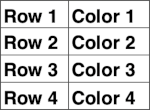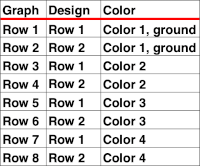A recent forum discussion on DBJ on Ravelry led to my looking back on some of my previous posts. Some of the features in both excel and numbers changed over the years, but most basics remain. Program-specific or a “software” general search in previous posts touch on GIMP, other programs, and other fabric design choices.
Color separations:
2013/04/DBJtest.pdf
2013/04/punching cards for DBJ_2.pdf
2013/05/14/vertical-striper-backing-on-brother-km/
2015/04/18/a-simple-shape-an-exercise-in-dbj-brother-km/
2013/04/21/double-jacquard1/
2013/04/22/double-jacquard-2/
2013/05/04/double-jacquard-3-single-bed-multi-color-slip/
2013/06/19/double-jacquard-separations-4_-making-them-work/
Added points on separations: the post addressing how to color separate for use on punchcard machines helps illustrate the how-tos involved in hand separations
Color changer:
2014/01/26/some-notes-on-machine-knitting-color-changers/
Ribber backing settings for DBJ 2017/11/09/a-return-to-brother-ribber-and-dbj-settings/
Ladder-back ribber settings illustrated (no actual pattern knitting involved), 2018/02/09/ladder-back-double-jacquard-backing-variations/
Double bed jacquard knitting allows for designing knits using multi color patterns without any concern for floats.
The ribber and a double bed color changer are necessary.
The ribber causes the floats to be knit into a second layer of fabric on the ribber side, hence the term double knit.
Only one color may be knit at a time.
Most color-changers only accommodate 4 colors, so in creating separations for double jacquard, this tends to be the maximum number for separations.
The more colors one uses in a row of knitting, the more all the stitches on the face of the fabric must stretch in order to accommodate the colors laid behind in the backing fabric.
The more the stitches on the front face of the fabric must stretch, the muddier the look of the design, with additional bleed or grin through of the backing colors through the stretched stitches.
Color separations are required.
The method of separation depends on the knitting technique to be used, the knitting machine one own and its capabilities, the desired look of the finished piece, and the time one wants to spend working on the separations.
Two of the most common backings are the striper technique, where the ribber knits horizontal stripes and is left set for normal rib throughout, and birdseye, sometimes called tweed or checkerboard, only achievable in ribbers with 1X1 needle selection.
Both techniques may be knit with tuck or slip cam settings.
The more colors per row the denser the fabric and the more grin/bleed throughwill be noticed on the knit side.
Separation Methods:
Method 1/A: always works.  Knitting in this case occurs for one design row at a time. The knit design row 1 will need to be expanded into 8 rows of knitting.
Knitting in this case occurs for one design row at a time. The knit design row 1 will need to be expanded into 8 rows of knitting.
The separation in the first chart must be elongated X 2 in order to make passes to and from the color changer.
The result is likely to produce elongation in the image, regardless of the backing method used.
In Japanese machines, one usually performs the first preselection row away from the color changer when using the automated color separation for 2 color dbj, KRC. Here the first preselection row is made toward the color-changer since each color will knit twice.
Passap is a bit different. In addition to its 4 color changer being on its right, the first pass to the left aligns pushers and needles, the second pass to the right preselects pushers for the first row to be knit after the color change on the right. The original design may have an even or odd number of rows since each row will be knit twice.
The results from this chart do not need to be elongated, each design row is expanded into 8, with each color knitting twice.  In Method 2/B: the separation occurs in two-row units.
In Method 2/B: the separation occurs in two-row units.
The carriage passes twice with each of the four colors.
One row of the design is knit going across to the bed, with the next row of the design knit when returning to the opposite side.
The ground color is split to the beginning and the end of the sequence.
In Brother the first preselection row is made moving away from the color changer.
The first pass back toward it should fill in the majority of the needles.
When the last row is reached, the color is changed back to the ground color
Row 2, the carriage will be on the right, heading back to the color changer as the sequence is completed.
The expectation is that the ground color, 1, will knit the majority of the needles. The separation sequence is repeated for each design row.
With the majority of needles knitting the first and last pass for each row one, in theory, the next pass will be knit on a row where stitches will not be attempted to be formed over a space not knit in the previous row, resulting in dropped stitches.  Method 3/C: is similar to Method 2, but the ground and background are not split into the first 2 rows of the graph.
Method 3/C: is similar to Method 2, but the ground and background are not split into the first 2 rows of the graph.
This is the hardest to achieve in terms of knitting without errors in patterning or dropped stitches, it also reduces elongation of the design.
The main color knits for 2 rows before the other colors knit, which may alter the availability of needles required for placement of the stitches in the next color row.  In both methods 2 and 3, the design must have an even number of rows.
In both methods 2 and 3, the design must have an even number of rows.
Method 4 is based on color layer separations. Machines such as the E 6000 allow the knitter to superimpose designs (rules for order may vary) and offers techniques for then performing the separation for the knitter, usually as seen in Method 1, lengthened.
There are Passap published reader techniques that will allow for the single pass for each color per row for 3 and 4 colors designs.
Any error-free hand separation for a pattern may be knit using the slip stitch setting, with appropriate DBJ color changes. The same pattern may be downloaded into the E6000, in turn, using Technique 129, color reverse, with the front lock set to LX.
The size of the motif for automatic color separation is dependent on the available Ram and the knitting machine model. This is a copy of one of my handouts when teaching DBJ eons ago  Another former handout, intended for Passap knitters. Many of these fabric options could be emulated on the Brother machine, if separation method 1 were available, with a bit of interpretation. A machine knitting cross reference chart
Another former handout, intended for Passap knitters. Many of these fabric options could be emulated on the Brother machine, if separation method 1 were available, with a bit of interpretation. A machine knitting cross reference chart  Automated color separations preparations for download happen easily when using Ayab and img2 track software and accompanying cables. In addition to the familiar built-in KRC separation, there are a variety of other options. For more information please see
Automated color separations preparations for download happen easily when using Ayab and img2 track software and accompanying cables. In addition to the familiar built-in KRC separation, there are a variety of other options. For more information please see
2019/12/31/dbj-more-than-2-colors-per-row-2/
2019/12/31/dbj-more-than-2-colors-per-row-1/
2020/01/20/revisiting-ayab_multiple-colors-per-row-dbj/